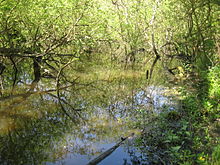Carr (landform): Difference between revisions
BabelStone (talk | contribs) better pic |
Copyedit per MOS:BEGIN. |
||
| Line 1: | Line 1: | ||
[[File:Moor Park alder carr.JPG|thumb|An alder carr at [[Moor Park, Farnham|Moor Park]], Surrey]] |
[[File:Moor Park alder carr.JPG|thumb|An alder carr at [[Moor Park, Farnham|Moor Park]], Surrey]] |
||
A '''carr''', the name of which is derived from the Old Norse '''kjarr''', meaning a swamp, is a type of waterlogged, wooded terrain that, typically, represents a [[Ecological succession|succession]] stage between the original reedy [[swamp]] and the eventual formation of [[forest]] in a sub-maritime [[climate]].<ref name="Whittow">Whittow, John (1984). ''Dictionary of Physical Geography''. London: Penguin, 1984. ISBN 0-14-051094-X.</ref> |
|||
The carr is one stage in a so-called [[hydrosere]]: the progression of vegetation beginning from a terrain that is submerged by fresh water along a [[river]] or [[lake]] margin. In sub-maritime regions, it begins with [[Reed bed|reed]]-swamp. As the reeds decay, the soil surface eventually rises above the water, creating [[fen]]s that allow vegetation like [[sedge]] to grow. As this progression continues, [[riparian]] trees and bushes appear and a carr landscape is created–in effect a wooded fen in a waterlogged terrain. At this stage the [[pH]] is not too [[acidic]] and the soil is not too deficient in mineral elements. Characteristic trees include [[alder]], [[willow]] and [[sallow]].<ref name="Whittow"/> |
A '''carr''' is a type of waterlogged, wooded terrain that, typically, represents a [[Ecological succession|succession]] stage between the original reedy [[swamp]] and the eventual formation of [[forest]] in a sub-maritime [[climate]].<ref name="Whittow">Whittow, John (1984). ''Dictionary of Physical Geography''. London: Penguin, 1984. ISBN 0-14-051094-X.</ref> The name derives from the Old Norse ''kjarr'', meaning a swamp. The carr is one stage in a so-called [[hydrosere]]: the progression of vegetation beginning from a terrain that is submerged by fresh water along a [[river]] or [[lake]] margin. In sub-maritime regions, it begins with [[Reed bed|reed]]-swamp. As the reeds decay, the soil surface eventually rises above the water, creating [[fen]]s that allow vegetation like [[sedge]] to grow. As this progression continues, [[riparian]] trees and bushes appear and a carr landscape is created–in effect a wooded fen in a waterlogged terrain. At this stage the [[pH]] is not too [[acidic]] and the soil is not too deficient in mineral elements. Characteristic trees include [[alder]], [[willow]] and [[sallow]].<ref name="Whittow"/> |
||
==See also== |
==See also== |
||
Revision as of 16:16, 16 November 2014

A carr is a type of waterlogged, wooded terrain that, typically, represents a succession stage between the original reedy swamp and the eventual formation of forest in a sub-maritime climate.[1] The name derives from the Old Norse kjarr, meaning a swamp. The carr is one stage in a so-called hydrosere: the progression of vegetation beginning from a terrain that is submerged by fresh water along a river or lake margin. In sub-maritime regions, it begins with reed-swamp. As the reeds decay, the soil surface eventually rises above the water, creating fens that allow vegetation like sedge to grow. As this progression continues, riparian trees and bushes appear and a carr landscape is created–in effect a wooded fen in a waterlogged terrain. At this stage the pH is not too acidic and the soil is not too deficient in mineral elements. Characteristic trees include alder, willow and sallow.[1]
